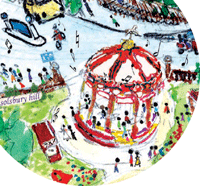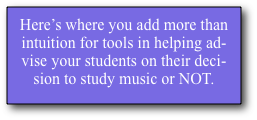 by Gary Powell
by Gary Powell
We think we listen to music from left to right like we read. When we whistle a tune, most of us whistle from left to right. Melodies undoubtedly move from left to right. That’s how it’s always been.
So, when the disc-jockey on the radio plays “name that tuneâ€, playing a half second of the song’s most uninteresting part, why do we still recognize it? It’s hardly moving in any direction, yet we might instantly recognize it and win a couple of movie tickets.
What’s at play here is your very personal brain’s recognition of a complex combination of musical elements: elements like instrumentation, texture, timbre, chordal voicing, chordal inversion, equalization, ambient sound, room reverberation AND….. whether or not you were hearing this song while getting your first kiss!
Music is deep. It almost defies explanation………………………….ALMOST!
Analogy might be the best instructor here. And, each of these analogies below has a rich musical heritage that is expressed in musical terms. This is the nature of learning music. Read music, don’t read music, educate yourself or shun study altogether. The music doesn’t ask or need to be understood. But, if the following statements make any sense to you whatsoever, you may possibly be interested in becoming a musician.
It’s a dynamic snapshot that may or may not predict its next picture.
It’s the only place where you are in the present, the past and the future at the same time.
The vertical gives meaning to the horizontal and the horizontal gives context to the vertical.
It’s a flag of a dozen layers of fabric stitched atop one another where one can clearly see all the patterns at the same time….all the while it passes by on horseback while your back is turned.
It has the passion of fire, but consumes nothing.
It’s something your mind can understand even when you cannot.
(Copyright 2005 Jesmax Music, BMI)

Lecture Level and Requirements
Is music appreciation an aptitude that is inherent or can it be learned? These are a series of exciting exercises to discern how your own personal brain perceives music. This is an excellent way for young people to decide how present music will be in their lives. Can be adapted for any level secondary and above. Inclusive of non-musicians.
All Content of Gary Powell’s Site is Licensed Under a
Creative Commons Attribution-NonCommercial-NoDerivs 2.5 License

.
 by Gary Powell
by Gary Powell
We think we listen to music from left to right like we read. When we whistle a tune, most of us whistle from left to right. Melodies undoubtedly move from left to right. That’s how it’s always been.
So, when the disc-jockey on the radio plays “name that tuneâ€, playing a half second of the song’s most uninteresting part, why do we still recognize it? It’s hardly moving in any direction, yet we might instantly recognize it and win a couple of movie tickets.
What’s at play here is your very personal brain’s recognition of a complex combination of musical elements: elements like instrumentation, texture, timbre, chordal voicing, chordal inversion, equalization, ambient sound, room reverberation AND….. whether or not you were hearing this song while getting your first kiss!
Music is deep. It almost defies explanation………………………….ALMOST!
Analogy might be the best instructor here. And, each of these analogies below has a rich musical heritage that is expressed in musical terms. This is the nature of learning music. Read music, don’t read music, educate yourself or shun study altogether. The music doesn’t ask or need to be understood. But, if the following statements make any sense to you whatsoever, you may possibly be interested in becoming a musician.
It’s a dynamic snapshot that may or may not predict its next picture.
It’s the only place where you are in the present, the past and the future at the same time.
The vertical gives meaning to the horizontal and the horizontal gives context to the vertical.
It’s a flag of a dozen layers of fabric stitched atop one another where one can clearly see all the patterns at the same time….all the while it passes by on horseback while your back is turned.
It has the passion of fire, but consumes nothing.
It’s something your mind can understand even when you cannot.
(Copyright 2005 Jesmax Music, BMI)

Lecture Level and Requirements
Is music appreciation an aptitude that is inherent or can it be learned? These are a series of exciting exercises to discern how your own personal brain perceives music. This is an excellent way for young people to decide how present music will be in their lives. Can be adapted for any level secondary and above. Inclusive of non-musicians.
All Content of Gary Powell’s Site is Licensed Under a
Creative Commons Attribution-NonCommercial-NoDerivs 2.5 License

.
 by Gary Powell
by Gary Powell

I love the analogies. Very expressive and insightful.
But I don’t get the listening and whistling left to right. The Chinese read right to left. Does that mean they listen right to left too? Or perhaps as you’re listening to a song, you’re envisioning the words in your head and they scroll left to right if you read left to right?
One more thing. I have noticed my brain remembers songs in movies quite well. I’ll hear a song on the radio and remember what scene in what movie I first heard it, but this is usually when the song is very fitting to the scene. However, it’s surprising because sometimes it’s a movie that I only saw once four years prior to hearing it in another venue.
Emma, in Western music we read from left to right, therefore our brains are mapped to relate forward motion or music heard over a period of time in a left to right perspective. This creates a direct relationship between reading and hearing. Chinese language creates the same perspective and no doubt a Chinese audience would think of the music “traveling” through time for right to left. It’s an interesting question. Let’s see if we can find out if this is true or not.
This linear explanation of music over time is only part of the story here. Our brains, conducted by a composer of some wit and depth, will live in the past, the present and the future all at the same time. Composers employ tools for foreshadowing harmonic progressions, melodic elements, not to mention texture, voicings and pitching two balls to the batter at once…..maybe even a dozen balls or more flying past your very intelligent mind at one time. Your brain knows where the balls came from and even may have predicted to you that they were coming. Popular music, for all it’s excitement, will never stilmulate the brain this way. There are certainly elements in pop music that excite our hips, but hardly enough to keep our minds occupied for more than a couple of plays.
Orgainized music, therefore, has the ability to exist “before”, “now”, and “after”, all at the same time. It’s simply, in the hands of a brilliant strategist, amazing. Thanks for you post and question. —GP
Emma, as to your second question about tonal memory being enhanced when connected within the framework of a movie, for instance. It’s not unlike blogging or websites with many links in and out of that frame of reference. More pathways are opened to more memory locations within the brain making is a much more stable memory. Maybe we could call it a “hyper-memory”….just click it and a full website of memories can be attached to a very small stimulus. The Richard’s Group of Education and Research has collected some excellent articles on this topic. Thanks again. — GP
Taken from a USA Today article about time travel, of course taken somewhat out of context, comparing a song that never ends to a time machine…
The time machine Ori proposes isn’t quite like the phone booth in Bill & Ted’s Excellent Adventure or Back to the Future’s DeLorean. Ori’s solution forms a closed, timelike curve. It’s a bit like a song that never ends. Think of each musical note as a point in space. As you sing the notes, you move forward in time. You can travel around the curve — sing the song — but when you get to the end, you are also at the beginning.
Just found it interesting.